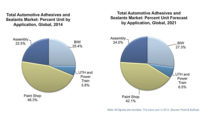
In North America, textiles and chemical supplies in general - and nonwoven products in particular - are undergoing a significant change. A global recession has affected many nonwoven end-use markets and led to greatly diminished demand. At the same time, new entrants and expansions by East Asian producers have resulted in additional capacity. This has led to lower operating rates for many producers, and more competitive market and pricing pressures; these drivers will continue. The loss of customer industries to overseas locations (especially China), market maturation and cost pressures from rising raw material and energy costs are other challenges. All of these factors combined have given rise to structural change.
According to P-183 Nonwoven Materials and Products, a new report from Business Communications Co. Inc., the global market for nonwoven fabrics is estimated at 9.1 billion pounds, valued at $13.4 billion in 2004. Rising at an average annual growth rate (AAGR) of 4.8%, this market is expected to reach 11.5 billion pounds by 2009. The developed nations of North America, Western Europe and Japan currently represent nearly 60% of the total market. However, this is changing as globalization leads to greater manufacturing activity migrating to China and similar nations. These nations are also developing mass-consumer markets. Both considerations will lead to greater global demand for nonwovens.
The global nonwovens industry has undergone some significant structural changes, and has recently faced a difficult operating environment. Conditions appear to have reached a trough, and a better environment is expected to emerge, although price wars have resulted in a loss of pricing power. The poor business environment of the last several years has placed pressure on margins, forcing a number of inefficient producers into bankruptcy and leaving most of the rest operating at very low levels. Inventories are lean, however, suggesting that a pickup in demand will quickly result in a larger volume of orders. Finally, a sustained global economic recovery is now morphing into an expansion. Pricing power has begun to return, but industry consolidation will continue.
North America still represents an important market for nonwovens. Growth markets for these products include filtration, wipes, home furnishings, building and construction, agricultural fabrics, floor covering, and miscellaneous disposables. Growth in the wipes and adult-incontinence markets has been high in recent years. Strategic development will target higher value-added application segments, though more room for growth will be achieved by product substitution of traditional materials by nonwovens. Other North American segments will see slow or even declining growth.
Globally, barriers to entry are moderate, and entry into the nonwoven fabric business is still possible. Companies generally have ready and equal access to the necessary production equipment and related technologies, which can be obtained through licensing agreements. Basically, specialized operations and extensive vertical integration can be important, and many suppliers reflect forward integration from fiber supply into fabrics supply. In other cases, nonwoven fabric producers have diversified downstream into converted and finished products. A technical base is of primary importance. New-product development, marketing and technical servicing are also keys to success in this industry. Most nonwoven fabric companies have adopted either a strategy of product differentiation by way of unique technology (e.g., spinbonding) or a strategy of focus (market segmentation) that is usually based on a product-type (e.g., geotextiles) basis. Product differentiation has also been achieved by way of corporate image.
Major competitors include Freudenberg, DuPont, Kimberly-Clark, BBA Nonwovens, PGI and Ahlstrom. Other organizations that have obtained strong global positions include Colobond (Acordis), Vita Nonwovens, Fibertex, Lydall, Polyfelt (OMV), Concert Industries, Textilgruppe Hof, and Jacob Holm Industries. Captive production and vertical integration have played a large role in this industry, especially in North America. Leading captive producers include Kimberly-Clark, Johns Manville, 3M and Georgia-Pacific. During the past three years, overcapacity and low pricing have been prevalent, especially in Western Europe, resulting in consolidation of the industry.
For more information, contact Business Communications Co. Inc., 25 Van Zant St., Norwalk, CT 06855; phone (203) 853-4266, ext. 309; or e-mail publisher@bccresearch.com.

